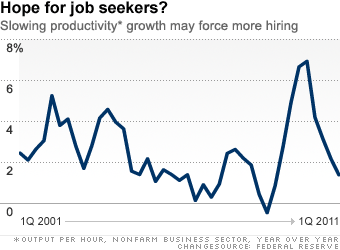为何企业很快会开始增聘人手

|
灰暗的就业前景中存在一丝亮点:过去几年雇员人数已压至如此之低,企业将不得不增聘人手(啊哈!)。 你或许会持怀疑态度,这是可以理解的。在失业率接近9%的情况下,美国企业界已实现大量利润——2010年四季度的年化利润额达到创纪录的1.68万亿美元。首次申请失业救济人数继2010年大部分时候下跌之后,正在再度攀升,而股市已接近高点。企业真的想增雇人手,改变这种状况吗? 答案是他们可能别无选择。招聘前景改善,很大程度上是因为一度推动盈利反弹的生产率改善趋势放缓,而过去两年活跃的股市亦式微。 单位小时经济产出过去12个月增长了1.3%,Capital Economics的保罗•艾许沃斯表示——增幅低于上一年的6.7%。 虽然生产率增速放缓长期并非好事,但这意味着财富创造减少以及经济增速放缓,在复苏早期阶段这对于劳动者是个不折不扣的好消息——说明近期雇员人手不足,不管上周五的就业报告说了什么。 生产率放缓说明雇主们通过采用降薪、裁员等简单方式实现生产率提升的空间已无——那些希望在下一周期实现增长的雇主们没有什么选择余地,只能增加人手。 “我们怀疑这些公司在提高生产率方面已无他计可施”,艾许沃斯上周四在致客户的一份报告中指出。 在2007-2009年的下行期间,美国企业不仅裁员数百万,而且还通过对留下来的员工施压,迫使他们更卖力地工作,在加薪和福利方面做出让步,最糟糕的是,不能再嘲弄老板的领带。 在复苏早期阶段,这种压力得到缓解,因为企业开始不再那么注重业务精简,而是更多地思考如何在下一轮销售增长中攫取更大份额。这往往会逐步带来一波雇佣潮。 要说本轮经济周期的这一阶段好不容易才来,仍嫌言有不达。有1,350万美国人失业,数百万人的工作时间不足,雇佣市场并不缺求职者。 而且,也没有多少迹象显示,在汽油价格高达4美元/加仑之时,有不满足于现状的雇员很快会要求更高的时薪或工资。以经济产出价格衡量的单位劳动力成本仍低于衰退前水平,而且2008年以来工资增速未超过过2%。不管怎样,第一步是要获得一份工作。 “生产率增速放缓在经济复苏的早期阶段非常典型,这是招聘潮即将到来的一个迹象,有时可能会有波动,”PNC经济学家罗伯特•戴表示。 这倒不是说失业率很快会大降,好日子又来了。招聘意愿上升会受到劳动者欢迎,但这会挤压企业利润率——这种变化不会受到股市的欢迎。 而且,如果真的有必要减少招聘,将不足以推动经济再次回暖。美国最大的问题是家庭和政府资产负债表上债务累累,你可能已经注意到我们在这方面进展不大。 但目前,为了有更多的工作岗位,让美国的富人们少捞点钱是值得的。 |
The bright spot in a drab employment picture is that workers have been stretched so thin during the past couple years that companies are going to have to (gasp!) hire more. You may be understandably suspicious. Corporate America has been raking in massive profits – they flooded in at a record $1.68 trillion annual rate in the fourth quarter of 2010 – with unemployment near 9%. Initial jobless claims are rising again after falling for much of 2010, yet the stock market is just short of record levels. Do companies really want to change this picture by hiring people and paying them and stuff? The answer is they may have no alternative. The hiring picture is improving largely because the productivity gains that drove the profit rebound and the rip-roaring stock market rally of the past two years are petering out. Hourly economic output rose at a 1.3% clip over the past 12 months, says Paul Ashworth of Capital Economics – down from 6.7% in the previous year. While falling productivity growth is bad over a long span, because it means less wealth creation and slower economic expansion, in the early stages of a recovery it is unabashedly good news for workers -- something that has been in short supply of late, whatever happens with Friday's jobs report. A productivity slowdown shows employers have harvested the low-hanging fruit of wage and employment cutbacks -- leaving those that aim to grow through the next cycle with little choice but to start staffing up. "We suspect that firms just ran out of potential productivity-enhancing measures," Ashworth writes in a note to clients Thursday. During the 2007-2009 downturn, companies not only shed jobs by the millions but also put the screws to workers who remained, forcing them to work harder, give ground on raises and benefits and, worst of all, stop mocking the boss' tie. In the early stages of a recovery, this pressure eases as companies start thinking less about staying in business than about competing for a bigger share of the next wave of sales growth. This typically leads over time to a wave of hiring. To say this last stage has been long in coming in this economic cycle is a major understatement. With 13.5 million Americans out of work and millions more working less than they'd like, there is no shortage of potential hirees. Nor is there much of a sign restive workers are on the verge of demanding better hours or higher wages, unhappy as they may be about $4 gasoline. Unit labor costs, measuring the price of economic output, remain below their pre-recession level, and wages haven't risen faster than 2% since 2008. The first step has to be to get a job, after all. "The fall in productivity growth is very typical in the early stages of a recovery, and gives us yet another sign we're in a hiring trend, as bumpy as it is at times," says PNC economist Robert Dye. This is not to say unemployment is about to plunge and that happy days are here again. While a shift toward hiring will be well received by workers, it will squeeze corporate profit margins – a development that won't be well received by the stock market. And if lower employment is surely necessary, it won't be sufficient to get the economy truly rolling along again. The biggest problem in the United States is the huge amount of debt weighing on household and government balance sheets, and you may have noticed we are not making a great deal of process on that front. But for now, a little less cream for the fat cats is a price well worth paying for some more jobs. |













